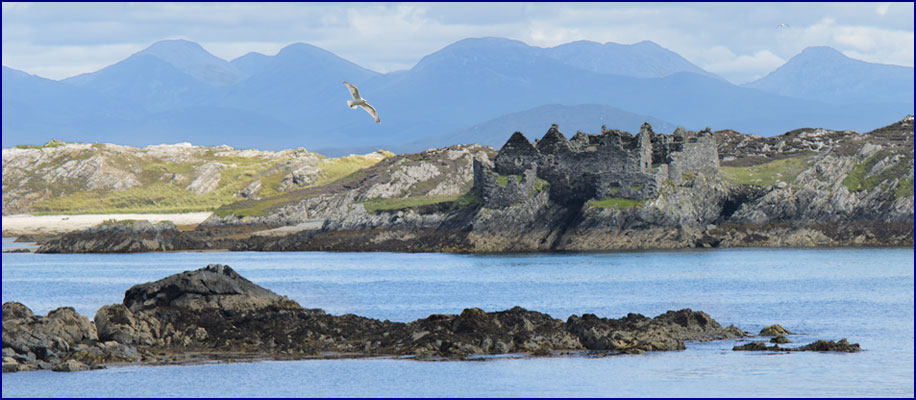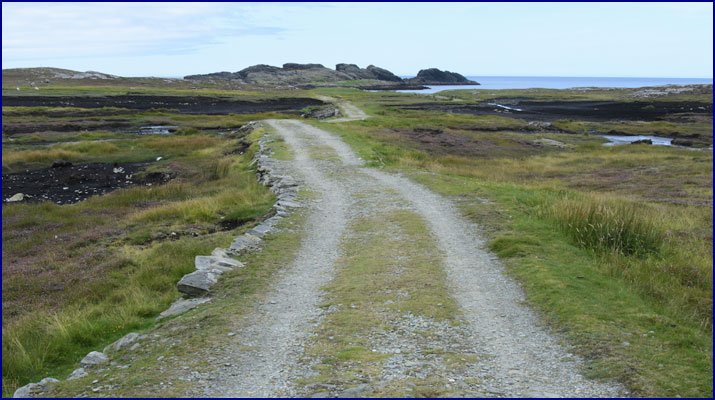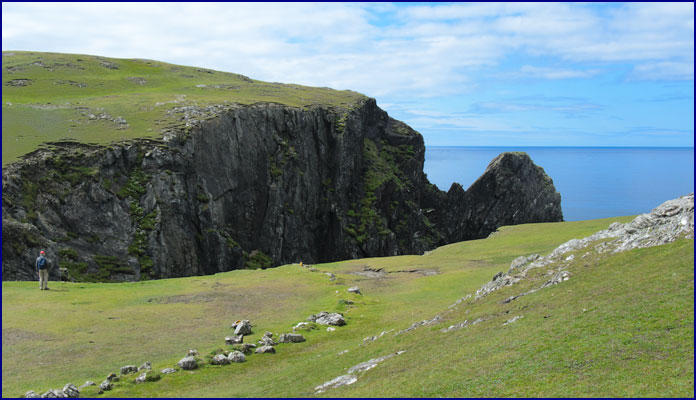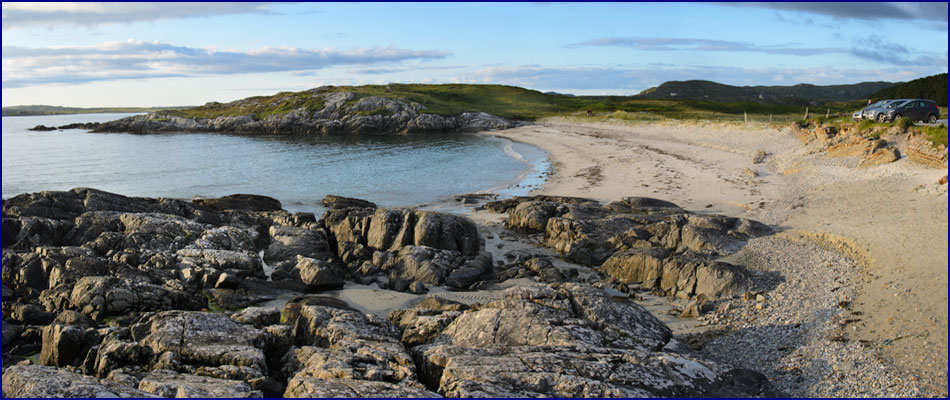|
Tuesday August 7
We had an excellent breakfast at the B&B, complete with
stewed rhubarb, something I had never tried before.
Not bad. Interestingly,
the lady who runs the B&B told us that she grew up living in
the little stone cottage by the gatehouse at the entrance to
Clifden Castle.
It was a brilliant sunny morning,
a perfect day to take a trip to Inishbofin Island.
We drove out to Cleggan on the northwestern tip of the
Connemara Peninsula to catch the ferry to Inishbofin.
Since we arrived a bit early we explored the area, driving
out to the point. It
was mostly green pastures with fences of stone, and we saw quite a
few beautiful Connemara ponies.
When we returned to Cleggan, a girl was riding one of the
ponies up the road right through town.
We parked in a private car park and got on the ferry, the Island
Discovery, along with about fifty other people.
It was a forty-five minute boat ride to the island, with
the wind in our faces and the Irish flag flapping overhead.
We felt like we were flying over the water, only to be
passed like we were standing still by a smaller boat known as the
‘Fast Ferry.’ Apparently
that one costs extra.
|

The Fort on Inishbofin Island
|
It
was a fine sunny day. As
the boat pulled in to Inishbofin we could see a castle-like ruin
near the port, the remains of an old army fort.
Once on dry land, we stopped at the visitor’s center for
a map, and set out to walk the Westquarter Loop, a five mile route
around the western half of the island.
Inishbofin means Island of the White Cow. The
island is similar to the coastal mainland, with small villages and
farms, and stone walls for fences.
We started out on a small paved road, but soon our route
took us through pastures and farmland.
We passed sheep sharing their paddock with seagulls, and
stopped to converse with a muddy white pig resting in his pen.
We followed a gravel lane through a pasture of ponies, but
they looked thin and poor, unlike the well-kept ponies we had been
seeing. The path
meandered down towards the water, and rock outcroppings and
heather lined the way.
We
came to an inlet and walked along a crescent-shaped beach of
stones, washed smooth and round by the sea.
We lingered, searching for the most perfectly shaped stones
to keep and take home. I
put a translucent white one in my pocket, impeccably smooth and
shaped like an egg – it fit perfectly in my hand and felt full
of luck.
Our
path climbed a hill overlooking the shoreline and crossed a peat
bog. People had
written their names or initials by arranging small white stones on
the dark peat soil, like biodegradable graffiti.
We crossed rolling green expanses punctuated by rock
formations. Blackbirds
flew overhead, and midges clouded around us if we stood still too
long. We stopped on a
rocky prominence above a cove and sat down to enjoy the untamed
beauty of this Atlantic shore.
|

On Inishbofin Island
|
Jineen noticed an odd object in the water of the inlet that was
vaguely canoe-shaped, and pulling out the binoculars, she
discovered it was a seal. Looking
closer, we could make out a number of them, both in the water and
on the rocky shore. Soon
they started to sing, their deep mellifluous voices rising in an
otherworldly harmony. The
sound they made was beautiful and haunting.
We skirted tall rocky cliffs above narrow
inlets. Huge boulders
littered the green moor, as if dropped from above.
Small islands of rock stood offshore, inhabited by a
million nesting birds. There
was a sandy beach far below, with a few bold swimmers braving the
chilly Atlantic waters. It
was almost warm enough that a swim seemed attractive.
Almost.
|

Inishbofin Island
|
We
passed a single gravestone, high on the cliff above the shore.
A plaque stated that it was in memory of three young men,
Martin, Michael and Peter Lacey, who drowned in these waters on
Easter Sunday, 1949.
Completing
the loop and returning to more inhabited areas, we stopped at a
hotel for lunch, and then headed down to the pier.
Along the way we found several lucky Irish
four-leaf-clovers. We
boarded the ferry, this time the Island
Explorer, and headed back to Cleggan.
Darned if that ‘Fast Ferry’ didn’t pass us again.
Back on the mainland we headed
toward Clifden, but taking the long route, following the smallest
roads along the coast. Skirting
an inlet, we drove out around the north side of the point that
juts out past Clifden and found to our surprise that Sky Road
makes a loop all the way around the peninsula – somehow we had
missed this in our earlier ventures.
Where the road turns back toward town we discovered a tiny
lane that leads out to the end of the point; we had somehow passed
this turnoff before without noticing it. We followed the little
road, lined with fuchsia, heather and wildflowers, all the way out
to the very tip of the peninsula, to where it ended at a beautiful
sandy beach. We looked
around in delight; who knew this was here?
That is one of the great things about exploring - you never
know what the road ahead will bring.
|

The beach off of Sky Road
|
The crescent of sandy
beach was small and secluded, and only a couple of other people
were there. We
followed the shoreline to our left, and soon we were in total
solitude. The sand
quickly gave way to a beach of stones, worn round and smooth from
a million years of surf. We
could hear a rattling clacking noise as each gentle wave came in,
rolling the stones against each other with a clatter.
We walked along slowly, searching for the perfect stone and
picking up the occasional shell.
Returning to the sandy strand, we
watched the sun lowering toward the water.
I took off my boots, rolled up my pants, and waded out into
the gentle surf. At
first the water felt icy cold but soon it was soothing - I
couldn’t talk Jineen into joining me.
I stood and watched the sun set in a brilliant crimson sky,
with the waves lapping round my legs as I bathed my tired feet in
the cold Atlantic. A
family arrived for a swim; the parents strolled along the beach
while the kids jumped off a small rock cliff into the chilly
waters.
We pulled out the
cheese, crackers and chutney, and opened a special bottle of wine,
the Villa Maria sauvignon blanc from New Zealand.
We agreed that this was one of the best Happy Hour spots
ever.
|